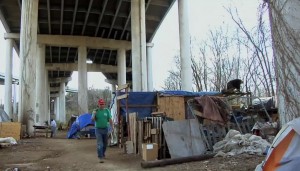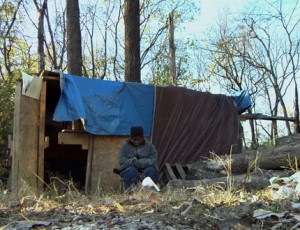Social Workers say “Tent City” Could Raise Empathy for the Homeless
“Tent City,” an Oprah Winfrey Network documentary that airs Thursday April 5 at 9 p.m. Eastern, looks at a homeless community that formed under a bridge in downtown Nashville, Tenn.
The residents support each other by sharing food tents and other necessities and keeping the site safe and clean. But then a flood hits and the community must struggle to stay together.
OWN asked social workers to review an advance copy of “Tent City.”
Our review team is Beth Davalos and Sarah Arnold.
Davalos, MSW, LCSW, is coordinator for the Seminole County Public Schools’ Families in Transition program, which helps homeless children and their families in economically struggling central Florida. Davalos also appeared on “60 Minutes” twice in 2011 and came to Congress to speak about the plight of homeless children.
Arnold is working toward a master’s degree in social work at Western Kentucky University. She is interested in working with homeless populations and is a member of the newly formed South Central Kentucky Coalition on Homelessness.
Here is our conversation with Davalos and Arnold about the documentary:
Q: On a scale of one to five stars, what would you give “Tent City”?
Davalos: I rate this documentary as a five. I thought it was an excellent portrayal of the struggles that many homeless people experience, displaying a deeper understanding of the physical, financial, emotional and political challenges. It encouraged the viewer to be empathetic regarding the plight of homelessness.
For example, one homeless man explained that he understood why the general public was scared of the homeless people that had just moved to Antioch. He then stated that it was a big change for the Antioch community and he could relate as they were going through a big change as well in their new Tent City. Displaying the parallel relationship of similar feelings and challenges helped viewers to relate to the struggles and efforts of those that are homeless. He then explained in the film that he was trying to get his life together again. In addition, the documentary did an excellent job of demonstrating the many complications that the homeless face on a daily basis such as limited employment and affordable housing, the complications of living in a shelter and a lack of case managers who could assist in guiding the homeless to self-sufficiency. Lastly, the strengths of the homeless individuals were portrayed as they lost their community and struggled to re-create it together. Once they found out that their voice could make a difference, the viewer could see that their demeanor changed. One could easily be impressed with their fight to get their basic needs met. At the same time, it was disheartening to observe them losing their rights to a legal “Tent City.”
Arnold: I agree with Beth. I give this documentary a five out of five because it hit the problem of homelessness right on target. Homelessness is not a problem because people use drugs and make bad decisions. Homelessness is a problem because our communities leave these people behind and try to pretend like they do not exist. Like what was pointed out at the end of the film, vouchers are great, but if there is no case management to ensure these people get to where they need to be, they will be right back on the streets again.
Q: In the film, Rev. Doug Sanders of the Otter Creek Church says homeless people tend
to be more isolated. So when an addiction or financial problem hits they
have fewer resources to avoid being homeless. Do you agree?
Arnold: Yes, I agree with Rev. Doug Sanders, the number one cause of homelessness is a lack of a support system. The individuals from this documentary are a great example. All of them are off drugs and trying to find employment. But, if there is no family or support system in place to help them find their path, they will not be successful. The idea of Tent City is wonderful because they are there to support each other but they are in need of more social support and acceptance from communities and employers than that.
Davalos: Often homeless individuals have already utilized most of the resources that they have had access to. They have little or no family support. Many do not have the coping skills or resources, such as funds for transportation and childcare or even a place to stay temporarily so they can deal with the complicated process of recovering from financial hardship. This is why it is imperative that case management is provided along with affordable housing. The case managers can guide people so that they can gain the resources and coping skills to become fully self-sufficient.
Q: The Tent City residents formed a community to empower themselves.
Do you think this is a strategy that would work with the homeless in
other parts of the country?
Arnold: Yes, I think forming a community to empower each other is a wonderful tool and it provides a sense of support. This sense of community could give them the tools to get out on their own and survive compared to other cities where individuals are on their own and may be unseen for days, weeks, or months. That empowerment is very helpful in getting out and being successful for those who are homeless or in a hard spot.
Davalos: In some areas of the county and for some sectors of the homeless population, tent cities are a viable, affordable temporary housing option. They generally require less economic support from the government than alternative choices like homeless shelters, subsidized housing when available, motels or apartments. Tent cities are also conducive to providing a supportive environment where people can develop a community and supportive environment, as seen in the documentary. However, there are a host of safety issues including sanitation, availability of clean running water, proper means for sewage disposal, safe and clean areas for bathing, lack of electricity, proper food storage and structural stability of dwellings, especially with changing weather conditions. Furthermore, tent cities are not appropriate for all homeless populations like families with children or people that need supervision due to medical or mental health issues. Lastly there is lot public and government resistance to tent cities and consequently obstructions to the formation of a tent city community. In order for it to work it would need large public support and financial assistance from the local community where it was located.
Q: Beth and Sarah, how would you describe the level of homelessness in your community? For instance is it at record levels, about the same, or improving?
Arnold: Currently I live in Bowling Green, Ky. and the homelessness problem here is very alive and real. With the economic state of the country the homeless population has grown quite a bit with the fastest growing population being women and children. I work with the South Central Kentucky Coalition on Homelessness and through that we are trying to get the word out on homelessness. The Bowling Green area has a strong sense of community already so if we can get the word out that we can help our neighbors by working together, I think the homeless problem can improve with time.
Davalos: I work with homeless families in Seminole County in central Florida. Currently, there are more than 10,000 homeless children in Central Florida. In my school district in Seminole County, we have 1,662 homeless school age children, which total about 850 families. This is 15 percent higher than a year ago and in the past four years the number of homeless children has increased by more than 300 percent. Our families have few housing options when they lose their homes. We only have only two shelters in our county. Many homeless families are forced to move to the neighboring county to access their homeless shelters. For the first time, in the history of Central Florida, shelters are at 100 percent capacity which means even living in a shelter is often not a choice. More than seven out of 10 families reside with friends, family or helpful strangers, living on their couches and living room floors. The children have to deal with being afraid that they will do something that will cause their family to lose their last housing option. In addition, many families are forced to live in weekly or daily rate motels while they support themselves with per diem labor. This makes it almost impossible to save enough money for more appropriate housing. This year I found 70 children that had been living with their families in their cars.
Q: How do you help clients who are homeless?
Arnold: As a member of the South Central Kentucky Coalition on Homelessness I have worked with many individuals who work directly with the homeless in our area and our biggest focus right now is to acquire some transitional housing in the area as well as develop a network of organizations to work together to assist the homeless and decrease the problem. We have many services in the area, we just need to get them to sit down and see what needs to be done and how to get the problem taken care of.
Davalos: In essence, school districts are the largest homeless service provider in the United States. That is because it is a school district’s federal responsibility to identify every homeless child that attends school in their district. It is then the district’s responsibility to implement the McKinney Vento Act to protect their homeless students’ rights.
However, as a social worker, I want to ensure that these children not only have access to an education, but all their basic needs are being met. We have found that the best way to approach this need is through empowering our clients, increasing awareness within the community and then collaborating services with other agencies. By collaborating, we rethink sustainable solutions that help individuals and families break the bondage of homelessness. We have been able to establish a large network of collaborative partners which helps us develop multiple channels of funding and other additional resources. A key component is that no collaborative member loses its identity or mission but rather finds more efficient and effective means to execute its individual goals. At the same time, the homeless families feel supported and empowered by being part of a community that is working together to make a difference in the lives of their children and their families.
Social workers are committed to equal treatment for all, including people living in poverty. To learn more visit the National Association of Social Workers’ Diversity and Equity web site by clicking here. And to learn more about how social workers help people who are homeless, read Family Safety Real Life Stories: From Homelessness to Independent Living at NASW’s “Help Starts Here” consumer web site by clicking here.
| Leave A CommentAdvertisement
Leave a Comment
You must be logged in to post a comment.






